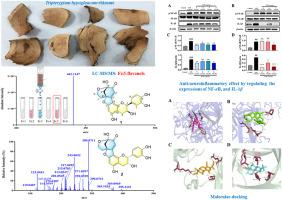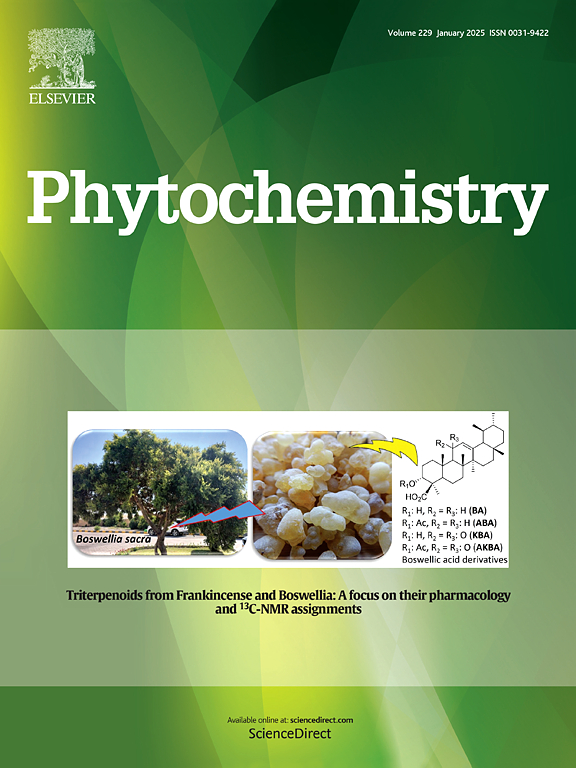黄烷醇-羟基酪醇杂种和二萜类化合物通过调节离体雷公藤根茎中NF-κB和IL-1β的表达而具有抗神经炎症活性
IF 3.4
2区 生物学
Q2 BIOCHEMISTRY & MOLECULAR BIOLOGY
引用次数: 0
摘要
本研究旨在鉴定雷公藤根茎中存在的抗神经炎化合物。Hutch同时阐明了它们在体外抗神经炎症的作用机制。在LC-MS分析的指导下,通过序贯色谱方法从T. hypoglaucum根茎中分离到7个先前未描述的化合物,包括一对黄烷醇-羟基酪醇杂种化合物(1-2)和3个二萜类化合物(5-7)。它们的结构由hresms, NMR光谱分析结合量子化学ECD计算确定。结果表明,化合物1 ~ 7对lps诱导的BV-2细胞具有明显的抑制NO生成的作用。化合物1-4降低磷酸化NF-κB的表达,从而减轻NF-κB的活化,而化合物5-7抑制IL-1β的表达,表现出抗神经炎症活性。化合物5进一步抑制炎症因子IL-6、IL-10和COX-2的产生。分子对接的结果与体外抗神经炎症相关的研究结果相补充,表明所有化合物都与相关靶点具有很强的结合亲和力,具有高能值,以及良好的Log P值、NHBD和NHBR的复合特性。总的来说,这些结构多样的化合物为开发治疗神经退行性疾病的药物扩大了候选分子的储备。本文章由计算机程序翻译,如有差异,请以英文原文为准。

Flavanol-hydroxytyrosol hybrids and diterpenoids with anti-neuroinflammatory activity by regulating the expressions of NF-κB and IL-1β in vitro from Tripterygium hypoglaucum rhizomes
The study aimed to identify the anti-neuroinflammatory compounds present in the rhizomes of Tripterygium hypoglaucum (Levl.) Hutch while simultaneously elucidating their mechanisms of action against neuroinflammation in vitro. Seven previously undescribed compounds, including a pair of flavanol-hydroxytyrosol hybrids (1–2) and three diterpenoids (5–7), were isolated from T. hypoglaucum rhizomes through sequential chromatographic methods under the guidance of LC-MS analyses. Their structures were determined by HRESIMS, NMR spectroscopic analysis combined with quantum-chemical ECD calculations. The anti-neuroinflammation activities of the isolates on LPS-induced BV-2 cells were evaluated that compounds 1–7 notably suppressed NO production to demonstrate anti-neuroinflammatory effects. Compounds 1–4 attenuated the expression of phosphorylated NF-κB, thereby mitigating NF-κB activation, whereas compounds 5–7 inhibited IL-1β expression to exhibit anti-neuroinflammatory activity. Compound 5 further inhibited the generation of inflammatory factors IL-6, IL-10, and COX-2. The results of molecular docking complemented the in vitro findings related to anti-neuroinflammation, demonstrating that all compounds exhibited strong binding affinity to the associated targets, characterized by high energy values, as well as favorable composite Log P values, NHBD, and NHBR. Collectively, these structurally diverse compounds expand the repertoire of candidate molecules for the development of drugs aimed at treating neurodegenerative diseases.
求助全文
通过发布文献求助,成功后即可免费获取论文全文。
去求助
来源期刊

Phytochemistry
生物-植物科学
CiteScore
6.40
自引率
7.90%
发文量
443
审稿时长
39 days
期刊介绍:
Phytochemistry is a leading international journal publishing studies of plant chemistry, biochemistry, molecular biology and genetics, structure and bioactivities of phytochemicals, including ''-omics'' and bioinformatics/computational biology approaches. Phytochemistry is a primary source for papers dealing with phytochemicals, especially reports concerning their biosynthesis, regulation, and biological properties both in planta and as bioactive principles. Articles are published online as soon as possible as Articles-in-Press and in 12 volumes per year. Occasional topic-focussed special issues are published composed of papers from invited authors.
 求助内容:
求助内容: 应助结果提醒方式:
应助结果提醒方式:


